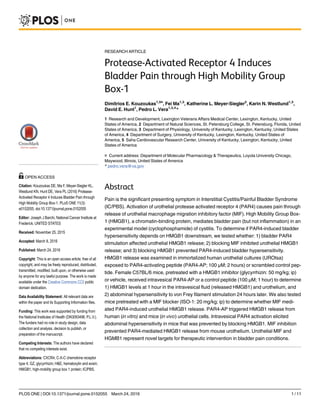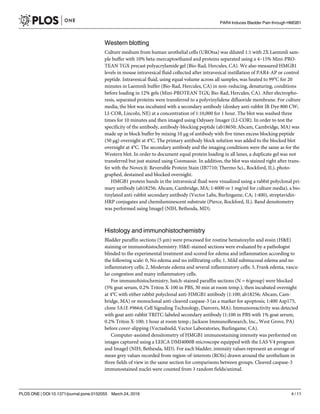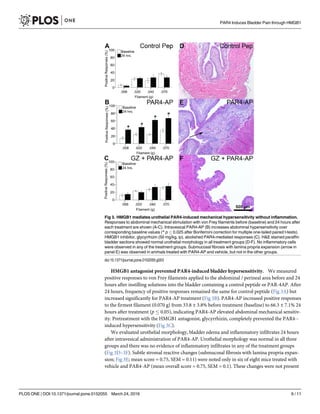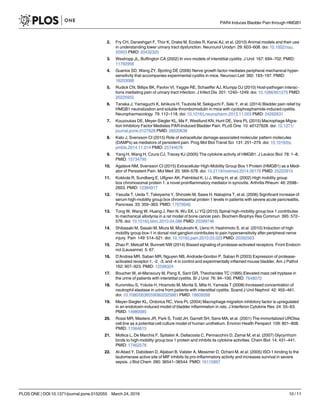1) This research article examines the role of high mobility group box 1 (HMGB1) in protease-activated receptor 4 (PAR4)-induced bladder pain.
2) In vitro and in vivo experiments showed that activation of PAR4 triggers the release of HMGB1 from urothelial cells.
3) Blocking HMGB1 prevented abdominal hypersensitivity in mice induced by intravesical PAR4 activation, suggesting HMGB1 mediates PAR4-induced bladder pain.

![Introduction
Bladder pain commonly occurs without obvious bladder pathology and is a cardinal symptom
of interstitial cystitis / painful bladder syndrome (IC/PBS), a chronic condition with unknown
etiology affecting 2.7–6.5% of women in the U.S. [1]. Rodent models of bladder pain histori-
cally relied on producing pain secondary to bladder injury and inflammation [2,3]. However
recent reports [4–7] show that bladder pain can be independent from bladder inflammation
including one where sequestration of high-mobility group box 1 protein (HMGB1, a nuclear
chromatin-binding protein) prevented bladder pain in a cyclophosphamide model of cystitis
without affecting inflammatory indicators [6].
HMGB1 is translocated to the cytoplasm and secreted by active and passive processes dur-
ing pathogenic infection or tissue injury [8]. Extracellular release of HMGB1 mediates both
inflammation, by acting as a proinflammatory cytokine [9], and pain, by directly affecting neu-
ronal activity [10]. Elevated levels are observed in inflammatory pain conditions like rheuma-
toid arthritis [11] and pancreatitis [12]. Blocking HMGB1 with anti-HMGB1 monoclonal
antibodies ameliorates pain behaviors in rodent models of neuropathic and bone cancer pain
[13,14] while injection of recombinant HMGB1 elicits pain behaviors in rodents [10]. Together
these findings indicate HMGB1 plays a key role in mediating pain at multiple sites, including
peripheral (e.g. organ) and central (e.g. spinal cord) levels [10].
Urothelial cells express protease-activated receptors (PARs) that are activated when prote-
ases cleave the tethered ligand [15,16]. Interestingly, IC/PBS patients have elevated urine prote-
ase levels [17,18], which presumably may lead to greater bladder PAR activation. We recently
showed that activation of urothelial PAR4 receptors triggered pain without causing overt
inflammation through a macrophage migration inhibitory factor (MIF)-mediated mechanism
[7]. Urothelial MIF is constitutively expressed and stored for release upon noxious stimuli to
further mediate downstream inflammatory changes and pain in the bladder [19]. Since
HMGB1 release can initiate pain independent of inflammation, we tested the hypothesis that
HMGB1 also mediates pain in our PAR bladder pain model.
To this end, we examined PAR4-induced HMGB1 release in human (SV40-transformed)
urothelial cells (UROtsa). In addition, in female mice receiving intravesical instillation of a
PAR4-activating peptide (AP), we tested (1) urothelial HMGB1 release; (2) HMGB1 inhibitor
antagonism of PAR4-induced bladder hypersensitivity; and (3) MIF inhibitor antagonism of
PAR4-induced HMGB1 release. Our findings revealed that bladder PAR4 receptor activation
elicits HMGB1 release from the urothelia through a MIF-mediated mechanism to cause blad-
der pain.
Materials and Methods
In vitro experiments
UROtsa cells (derived from the urothelium lining of benign human ureter immortalized with
SV40; a gift of Scott H Garrett [20]) were used as an in vitro model of normal urothelium. Cells
were plated in 24-well plates (five replicates per treatment group) at a density of 6 x 104
cells/ml
overnight in DMEM with 10% FBS. Cells were synchronized 1 hour in fresh DMEM (with 0.1%
BSA) before replacing media with DMEM (with 0.1% BSA) containing a human PAR4-activating
peptide (AYPGKF-NH2) or a scrambled control peptide (YAPGKF-NH2) at 100 μM (Peptides
International, Inc., Louisville, KY). Culture medium was collected at 2 hours, and assayed for
HMGB1 by western blotting.
PAR4 Induces Bladder Pain through HMGB1
PLOS ONE | DOI:10.1371/journal.pone.0152055 March 24, 2016 2 / 11
Interstitial Cystitis / Painful Bladder Syndrome; ISO-1,
(S,R)3-(4-hy-droxyphenyl)-4,5-dihydro-5-isoxazole
acetic acid methyl ester; MIF, macrophage migration
inhibitory factor; PAR, protease activated receptor;
PAR4, protease activated receptor 4; PAR4-AP,
PAR4-activating peptide; Pep, peptide; RAGE,
receptor for advanced glycation endproducts; ROI,
region of interest; TLR4, toll-like receptor 4; Veh,
vehicle.](https://image.slidesharecdn.com/77f1f1be-6637-4ceb-9d12-67a510044760-161124051348/85/pone-0152055-2-320.jpg)
![In vivo experiments
All animal experiments were approved by Lexington Veterans Affairs Medical Center Institu-
tional Animal Care and Use Committee (VER-11-016-HAF) and performed according to the
guidelines of the National Institutes of Health.
Abdominal mechanical hypersensitivity testing
Abdominal mechanical hypersensitivity was tested in mice (13–17 week-old female C57BL/6;
Jackson Laboratory, Bar Harbor, ME) as previously described [7]. Briefly, von Frey filaments of
ascending bending force (0.008, 0.020 0.040, 0.070 g) were pressed to the lower abdominal
region in trials of 10 before (baseline) and 24 hours after PAR4 peptide instillation to detect
referred bladder pain. Positive response was defined as any one of three behaviors: 1) licking
the abdomen, 2) flinching/jumping, or 3) abdomen withdrawal. Mice responding more than
30% to the weakest filament (0.008 g) during baseline testing were excluded from the study.
The experimental design is illustrated in Fig 1.
Intravesical instillation of PAR4 peptides and bladder collection
Isoflurane-anesthetized mice were transurethrally catheterized (PE10, 11 mm length) and
drained of urine [7]. Fifteen minutes before instillation, mice received either HMGB1 antago-
nist [21], glycyrrhizin (50 mg/kg, ip; Calbiochem, Billerica, MA), glycyrrhizin vehicle control
(10 μM NH4OH in sterile PBS, pH 7.4; ip), or MIF antagonist, (S,R)3-(4-hy-droxyphenyl)-
4,5-dihydro-5-isoxazole acetic acid methyl ester [22] (ISO-1; 20 mg/kg, ip; EMD Bioscience,
San Diego, CA; catalog 475837). Bladders were instilled with either PAR4-activating peptide
(AYPGKF-NH2; 100 μM in PBS; pH 7.4, 150 μl) or a scrambled control peptide
(YAPGKF-NH2; 100 μM in PBS; pH 7.4, 150 μl) and retained for 1 hour. Intravesical fluid was
collected from the catheter tip, treated with protease inhibitors (Halt III; Thermo Sci., Rock-
ford, IL), and stored at -80°C until analysis.
Twenty-four hours after instillation, mice were tested for abdominal mechanical allodynia
(as above) and then anesthetized (isofluorane anesthesia). Bladders were removed, fixed in
10% formalin, and embedded in paraffin for histology (see below).
Fig 1. The flow chart demonstrates in vivo study in mice with treatments.
doi:10.1371/journal.pone.0152055.g001
PAR4 Induces Bladder Pain through HMGB1
PLOS ONE | DOI:10.1371/journal.pone.0152055 March 24, 2016 3 / 11](https://image.slidesharecdn.com/77f1f1be-6637-4ceb-9d12-67a510044760-161124051348/85/pone-0152055-3-320.jpg)



![in the groups receiving control peptide or the group receiving glycyrrhizin pre-treatment and
PAR4-AP treatment (mean overall score = 0, both groups).
MIF antagonist prevented PAR4-induced urothelial HMGB1 intensity
decrease
Since we previously reported that MIF mediates PAR4-induced bladder hypersensitivity [7],
we investigated whether MIF mediates bladder pain by modulating HMGB1 release. Strong
HMGB1 immunofluorescence was detected in urothelial nuclei of mice treated with control
peptide (Fig 4A), whereas intravesical PAR4-AP administration reduced urothelial HMGB1
immunofluorescence (Fig 4B) after 1 hour of exposure. Pretreatment with MIF antagonist,
ISO-1, prior to intravesical PAR4 instillation, completely prevented this reduction of urothelial
HMGB1 immunofluorescence (Fig 4C). Control slides where primary antisera were omitted
had no immunofluorescence (not shown). Quantitative image analysis of the urothelia (Fig
4D) showed that PAR4-AP administration reduced urothelial HMGB1 by 41.7% compared to
controls (p 0.01), whereas ISO-1 pretreatment blocked the reduction induced by bladder
PAR4-AP infusion and actually elevated HGMB1 levels (Fig 4C and 4D; p 0.001).
Discussion
Our results demonstrate a novel finding: activation of urothelial PAR4 receptors elicits
HGMB1 release from both human and mouse urothelial cells. This conclusion is supported by
the increased levels of HMGB1 seen in the intravesical fluid of mice and in the culture media of
human urothelial cells following exposure to PAR4-AP. We also documented a decrease in
nuclear HMGB1 in the urothelium of mice after exposure to PAR4-AP which complements
the intravesical findings.
The present study, not only confirms our earlier findings [7] that PAR4 activation induced
bladder pain but also extends them by showing that such bladder pain can be prevented by
administration of a HMGB1 antagonist (glycyrrhizin). Our findings are in agreement with the
Fig 4. Urothelial PAR4-induced HMGB1 intensity decrease is mediated through MIF. Panels (A-C) show
urothelial HMGB1 immunofluorescence 1 hour after intravesical exposure to control peptide, PAR4-AP, or
PAR4-AP after pretreatment with MIF antagonist, ISO-1 (ip). White arrows identify the intravesical surface of
the urothelium. Less urothelial HMGB1 immunofluorescent labeling is apparent in PAR4-AP exposed
bladders (B) than in control peptide-treated bladders (A). Pretreatment with MIF-1 antagonist ISO-1
prevented this decrease (C). Quantitative image analysis (D) revealed that average urothelial HMGB1
immunofluorescence significantly decreased after intravesical PAR4-AP administration in comparison to
control peptide-treated animals (** p 0.01), indicating urothelial release of HMGB1. In contrast, ISO-1
pretreatment elevated urothelial HMGB1 immunofluorescence from PAR4-AP administration (***
p 0.001), suggesting MIF antagonism blocks HMGB1 release.
doi:10.1371/journal.pone.0152055.g004
PAR4 Induces Bladder Pain through HMGB1
PLOS ONE | DOI:10.1371/journal.pone.0152055 March 24, 2016 7 / 11](https://image.slidesharecdn.com/77f1f1be-6637-4ceb-9d12-67a510044760-161124051348/85/pone-0152055-7-320.jpg)
![observations of Tanaka et al. [6] who reported that HGMB1 mediated pain caused by a chemi-
cal model (cyclophosphamide) of cystitis in mice.
Lastly, since we showed that PAR4 activation induced MIF release and bladder pain that
were blocked by a MIF antagonist (ISO1) [7], we tested whether MIF was upstream of HMGB1
release in our model. In fact, our current results show that a MIF antagonist (ISO1) also pre-
vents PAR4-induced urothelial HMGB1 release. Thus, the current study provides a mechanism
for our findings that PAR4 activation induces bladder pain mediated by MIF [7] by providing a
mechanism (release of urothelial HMGB1) for this pain.
Our current findings using a model that results in no urothelial damage or frank inflamma-
tion provide a mechanism for MIF-mediated pain that we reported using other models of blad-
der inflammation (cyclophosphamide cystitis) [23]. Thus, our current and past experimental
observations [7,23] indicate that MIF likely plays a pivotal role in mediating bladder pain, at
least in experimental models of bladder pain and cystitis.
Therefore, we propose that activation of urothelial PAR4 by proteases (either in the urine or
produced by local inflammatory events) is likely to elicit urothelial MIF release. Released MIF
then binds to urothelial MIF receptors [7] resulting in HMGB1 release from urothelial cells. In
turn, released HMGB1 interacts with receptors localized at nerve endings or on the urothelium
relaying signals to the nerve endings to elicit bladder pain [6,24,25].
HMGB1, is a ubiquitous nuclear non-histone DNA-binding protein that signals tissue dam-
age when passively released from cells during apoptosis [26]. Cleaved caspase-3 staining showed a
few cells stained in top layer of urothelium as a regular program death of umbrella cells in all
groups. Since no immunohistochemical difference (cleaved caspase-3 staining) was observed in the
urothelium of PAR4-AP treated mice, we consider it unlikely that PAR4-AP treatment is causing
apoptotic changes in the urothelium that account for HMGB1 release. Endogenous HMGB1 can
also be actively released from cells as a result of inflammatory stimuli (e.g. LPS, TNF) to mediate
further inflammation and also pain (for a review see Kato Svensson, 2015 [8]).
The physiological activity of HMGB1 depends on the redox-state of its 3 cysteine groups
[27]. In the fully reduced state (all-thiol), HMGB1 is a chemoattractant acting through the
receptor for advanced glycation endproducts (RAGE). In the partially reduced state (disulfide),
HGMB1 induces cytokine expression and mediates inflammation through binding with TLR4
receptor. Fully oxidized HGMB1 has no known physiological activity.
Recent evidence shows that HGMB1 can mediate pain by acting at the organ level (as is the
case in this study) [6] and also at spinal levels [28,29], but the mechanisms for inducing pain
are still being investigated. All-thiol HGMB1 mediates dorsal root ganglia neuronal excitability
in vitro through RAGE receptors while the disulfide form mediates nociception at the spinal
cord level in vivo [24]. Tanaka reported that bladder pain from cyclophosphamide injection
was prevented by systemic administration of a RAGE antagonist [6] but the HMGB1 redox
form was not investigated. Therefore, the redox form of HGMB1 that mediates bladder pain in
our model (urothelial PAR4 activation) and the receptor for HGMB1-mediated bladder pain,
remain to be investigated.
Urothelial basal and intermediate cells co-express MIF, a cytokine involved in pain and
inflammatory processes [19], along with PAR1 and PAR4 receptors [16,30]. We previously
showed that, when stimulated, PAR1 and PAR4 receptors elicit urothelial MIF release to medi-
ate additional inflammatory changes and bladder pain [7,19,23,30]. The exact mechanism
whereby MIF is acting as a nociceptive molecule is not known, but it is likely to involve MIF
binding to one of its receptors (CD74, CXCR2 or C-X-C chemokine receptor type 4 (CXCR4)
[31]). Interestingly, we previously showed that an antagonist of CXCR4 reduced bladder pain
after PAR [7]. Whether, CXCR4 antagonism or antagonism of any of the other MIF receptors
can prevent PAR4 induced HMGB1 release is not known but will be investigated.
PAR4 Induces Bladder Pain through HMGB1
PLOS ONE | DOI:10.1371/journal.pone.0152055 March 24, 2016 8 / 11](https://image.slidesharecdn.com/77f1f1be-6637-4ceb-9d12-67a510044760-161124051348/85/pone-0152055-8-320.jpg)
![In summary, our study shows that bladder pain may be modulated by disrupting several dis-
tinct molecules. Preventing urothelial PAR4 from becoming activated represents the highest
point in the activation cascade sequence. Preventing the released MIF from binding one (or sev-
eral) of MIF’s receptors after PAR4 activation may prevent HMGB1 release. Finally blocking
released HMGB1 from binding to its receptors may block pain. The contribution of intracellular
signaling pathways is unclear and needs to be studied further. These events offer multiple control
points that may offer therapeutic targets to relieve bladder pain in clinical conditions such as IC/
PBS. Whether these molecules are also elevated in clinical conditions remains to be determined.
IC/PBS patients show elevated urine protease levels [17,18], which presumably may lead to
greater bladder PAR activation, and in turn, bladder hypersensitivity. Our model of intravesical
administration of PAR peptides to induce bladder pain may be replicating this process [7].
Conclusions
Intravesical stimulation of bladder PAR4 receptors induced bladder pain in this study by elicit-
ing urothelial HMGB1 release through a MIF-mediated mechanism. These findings suggest
that MIF, acting upstream of HMGB1, plays a key role in mediating bladder pain. Both mole-
cules represent novel targets for therapeutic intervention in bladder pain conditions. Future
studies will examine the contribution of specific receptors activated by MIF and HMGB1 in
mediating bladder pain.
Supporting Information
S1 Fig. Commassie-stained gel shows equivalent protein in each lane. Human epithelial cells
(UROtsa) culture media (from samples used in Fig 2A) were loaded on a gel, electrophoresed
and stained for protein using a Commassie procedure.
(JPG)
S2 Fig. Protein-stained gel shows equivalent protein in each lane. Human epithelial cells
(UROtsa) culture media (from samples used in Fig 2A) were loaded on a gel, eletrophoresed
and stained for protein.
(JPG)
S1 File. Raw data used for the analyses and figures.
(ZIP)
Acknowledgments
Judy Glass and Xiu Xu provided excellent technical assistance. This material is the result of
work supported with resources and the use of facilities at the Lexington (Kentucky) Veterans
Affairs Medical Center.
Author Contributions
Conceived and designed the experiments: DK FM KLMS PLV. Performed the experiments: DK
FM. Analyzed the data: DK FM PLV KNH DEH. Wrote the paper: DK FM KLMS KNH DEH
PLV.
References
1. Berry SH, Elliott MN, Suttorp M, Bogart LM, Stoto MA, Eggers P, et al. (2011) Prevalence of symptoms
of bladder pain syndrome/interstitial cystitis among adult females in the United States. J Urol 186: 540–
544. doi: 10.1016/j.juro.2011.03.132 PMID: 21683389
PAR4 Induces Bladder Pain through HMGB1
PLOS ONE | DOI:10.1371/journal.pone.0152055 March 24, 2016 9 / 11](https://image.slidesharecdn.com/77f1f1be-6637-4ceb-9d12-67a510044760-161124051348/85/pone-0152055-9-320.jpg)

